Jeremy C. Shia, Masayo Yabu, Kim Van Tran, and Michael S. Young
Waters Corporation (Milford, MA, USA)
Application advantage
♦ Significantly improved retention and resolution of paraquat and diquat compared to existing HILIC methods.
♦ CORTECSTM UPLC ® HILIC columns provide baseline separation between paraquat and diquat, allowing MS and UV detection to use the same chromatographic parameters.
Waters Solutions
ACQUITY UPLC ® H-Class System
ACQUITY ® TQD Mass Spectrometer
CORTECS UPLC HILIC column
Oasis ® WCX cartridge
Keywords <br> diquat, paraquat, UPLC / MS / MS, UPLC / UV, SPE, drinking water, HILIC, CORTECS
Quaternary ammonium salts Profile herbicide paraquat and diquat <br> are doubly charged (FIG. 1). They are widely used worldwide to control crops and aquatic weeds. The highest level of contaminant (MCL) in drinking water specified by the US Environmental Protection Agency (EPA) is 20 μg/L (20 ppb). Paraquat is classified as a pesticide by the EPA. In order to ensure drinking water quality, the European Union (EU) Committee sets the lower limit of a single herbicide was 0.1 μg / L (100 ppt) 1. After the Swedish authorities ruled a bill in 2007, the EU also banned the continued use of paraquat. Diquat and paraquat are very polar and difficult to retain on C18 columns using reversed-phase liquid chromatography. Most published methods, including US EPA Method 549.2, require the addition of a sodium hexane sulfonate plasma pairing reagent to the mobile phase to achieve the desired retention time and resolution in both quaternary ammonium analytes. . In order to meet the extremely low quantitative requirements set by countries and institutions such as the European Union, mass spectrometry (MS) has become a necessary detection method. However, the use of ion pair reagents can have significant ion suppression effect on MS detection. As an alternative technology, hydrophilic interaction chromatography (HILIC) has certain advantages over ion-pair chromatography. The MS ionization efficiency is improved because there is no need to add an ion pair reagent. Secondly, the organic solvent content in the extract is usually very high and can be directly entered into the column without dilution with the aqueous phase mobile phase containing the ion pair reagent. This application note demonstrates that UPLC separation using the CORTECS UPLC HILIC column can significantly improve the retention time and resolution of both analytes, enabling detection of a minimum of 500 ppt using only one UV detection method.
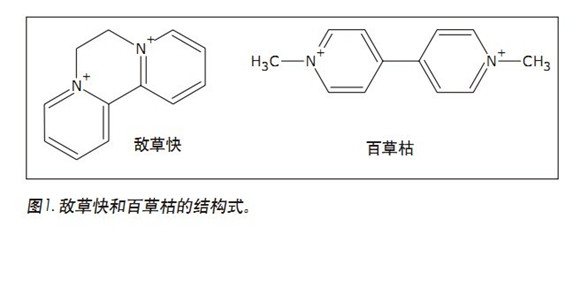
experiment
Sample Description <br> First, the tap water is dechlorinated with sodium thiosulfate. Ammonium phosphate was added to adjust the pH of all samples to about 7. The sample was then loaded onto an Oasis WCX cartridge. Sample enrichment is achieved by reducing the volume of the SPE eluate by evaporation and concentration. The detailed SPE steps are shown in Figure 2.
UPLC Condition <br> system: with ACQUITY UPLC H-Class column system photodiode array (PDA) detector of: CORTECS UPLC HILIC 1.6 μm, 2.1 x 100 mm ( Part No. 186007106)
Mobile phase (isocratic): 50:50 A/B
Mobile phase A: 200 mM ammonium formate buffer, pH 3.7
Mobile phase B: acetonitrile injection volume: 20 μL
Column temperature: 30 °C
Wash solvent: acetonitrile / water (50:50)
Purge Solvent: Acetonitrile / Water (50:50)
Flow rate: 0.5 mL/min
PDA detection conditions: Diquat is UV 308 nm, paraquat is UV 257 nm
Vial: Polypropylene Autosampler vial (p/n 186002642)
Table 1 summarizes the MRM channel and LC/MS parameters used in this study.
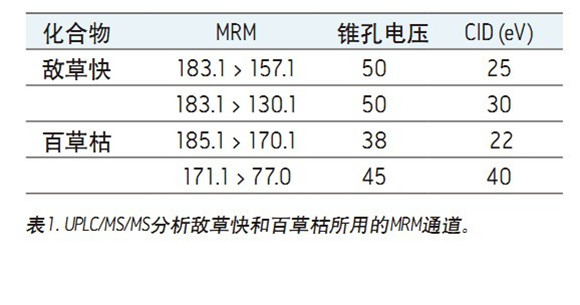
Reagent
1. Accurately weigh 23 g of ammonium dihydrogen phosphate in a pH-adjusting buffer (400 mM phosphate buffer, pH 7) and add to a 500 mL volumetric flask. Water (Milli-Q or equivalent) is added to completely dissolve it and then diluted to about 400 mL. Ammonium hydroxide solution was added to adjust the pH to 7.2. Dilute to the mark with water.
2. SPE activation and washing solution (10 mM pH 7 phosphate buffer) Take 10 mL of the above 400 mM pH 7 concentration buffer and dilute to 400 mL with water.
3. SPE eluent (10:90 formic acid/acetonitrile) Add 50 mL of formic acid to 450 mL of acetonitrile and mix well.
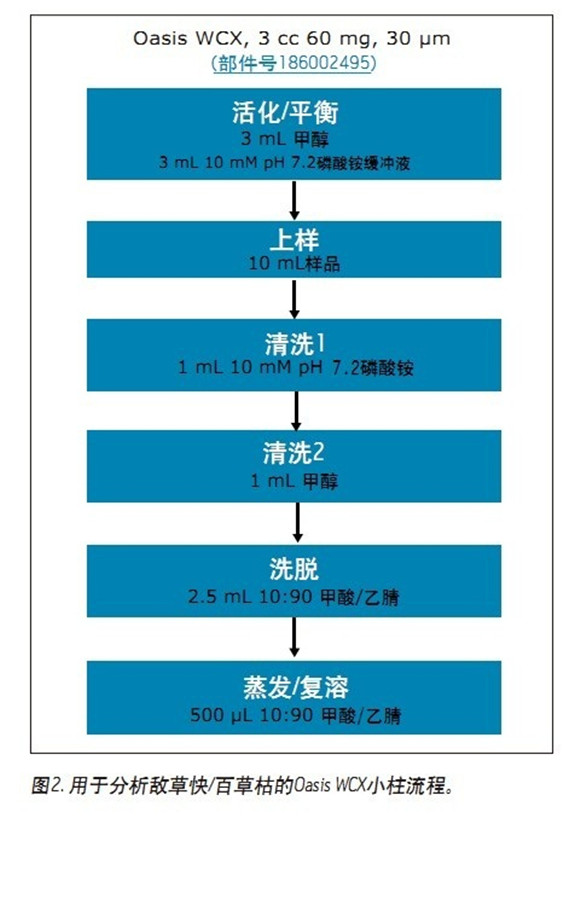
MS condition
Mass spectrometer: ACQUITY TQD
Ionization mode: Electrospray positive ion source temperature: 150 °C
Desolvation gas temperature: 350 °C
Desolvent gas flow rate: 800 L/h
Cone gas flow rate: 30 L / h
Collision gas flow rate: 0.20 mL/min
Data Management: MassLynx ® Software
Sample preparation <br> NOTE: All sample collection and sample preparation steps should be used polypropylene containers. A UPLC analysis is recommended using a polypropylene autosampler vial (part number 186002642).
Sample pretreatment
2. SPE enrichment and purification
Transfer 10 mL of the sample to a suitable polypropylene container (15 mL centrifuge tube used in this experiment). If the sample has been chlorinated, add 50 μL of 20 mg/mL sodium thiosulfate and mix well. To all samples, 25 μL of 400 mM pH 7 phosphate buffer was added to adjust the pH. SPE enrichment and purification with Oasis WCX cartridges (see Figure 2 for SPE details). A 30 cc polypropylene reservoir (part number WAT011390) was attached to each cartridge to load a 10 mL sample.
Results and discussion
In a previous publication 2 , the diquat and paraquat in drinking water were analyzed using an ACQUITY UPLC BEH HILIC column. The method uses MS detection with high sensitivity and a LOQ of 40 ng/L. However, when UV was used as the detector, diquat and paraquat could not reach baseline separation (Fig. 3A). When the CORTECS UPLC HILIC column uses the same instrument parameters, both compounds retain improved retention and resolution (Figure 3B). Therefore, using the CORTECS UPLC HILIC column, you can use not only MS but also UV detection. To optimize peak shape and analysis time, the final concentration of ammonium formate buffer in mobile phase A was increased from 150 mM to 200 mM and the mobile phase composition was adjusted from 40:60 A/B to 50:50 A/B.
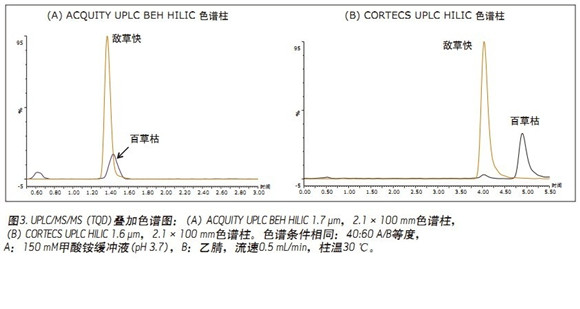
Figure 4 shows a typical UPLC/UV chromatogram of a tap water sample spiked with 500 ng/L diquat and paraquat. The sensitivity of UPLC combined with tandem MS technology is much higher than that of UV detection, so the concentration that can be detected reaches 50 ng/L. Figure 5 shows a typical UPLC/MS/MS chromatogram of a tap water sample spiked with 50 ng/L diquat and paraquat. Tables 2 and 3 show recovery data for repeated analyses of spiked water samples of 500 ng/L and 50 ng/L, respectively. Typical matrix-matched calibration curves for both MS and UV detection are linear. The MS test calibration standard is 25 to 2000 ng/L, and the UV detection is 100 to 5000 ng/L. The calibration curve is shown in Figure 6 (UV) and Figure 7 (MS/MS).
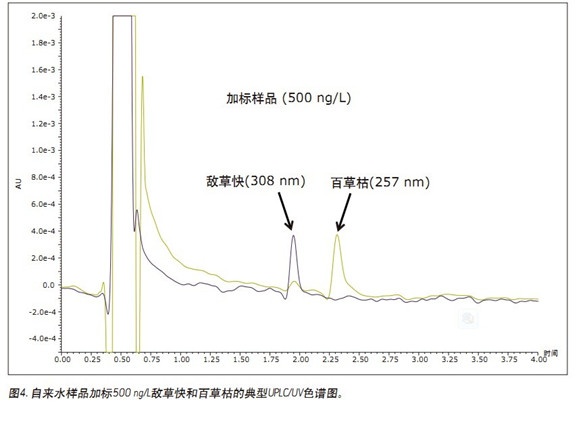
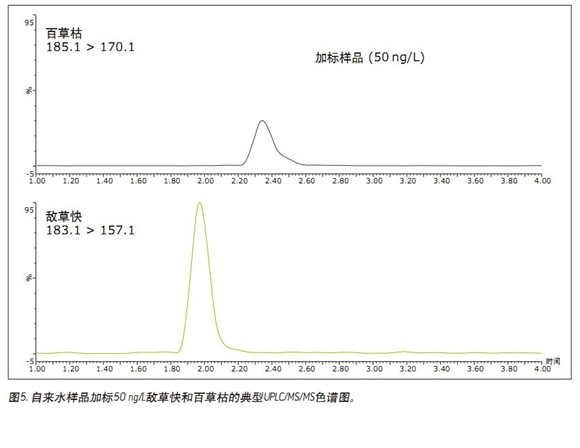
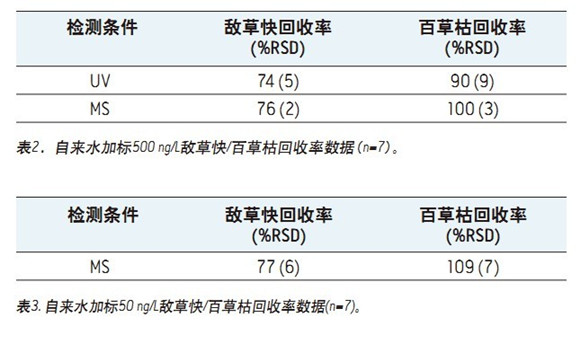
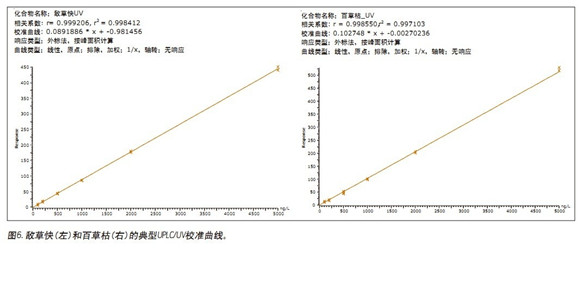
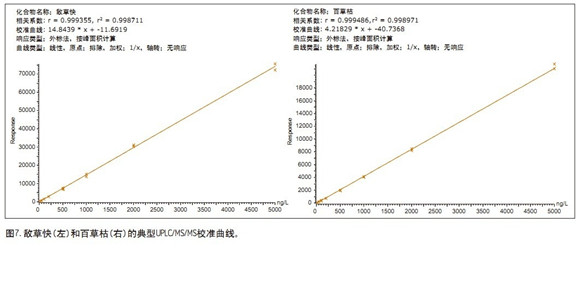
Performance of the UV detection method <br>The method detection limit (MDL) is determined according to the method defined in US EPA Method 549.2, and the method performance is evaluated by the following formula: MDL = S t (n-1, 1-alpha = 0.99)
Where: t (n-1, 1-alpha = 0.99) = t-test value with a confidence of 99% and a degree of freedom of n-1
n = number of repetitions (7)
S = standard deviation of repeated analysis
Table 4 summarizes the MDL results calculated from the UV analysis recovery data of the tap water sample spiked with 500 ng/L. The performance of this method is equal to or better than EPA Method 549.2.

Conclusion <br> With CORTECS UPLC HILIC Columns retain the excellent performance and separation capacity, diquat and paraquat peak achieved baseline separation. This allows tandem MS or UV to be detected using the same chromatographic parameters. The combination of UPLC and tandem MS makes the sensitivity of the method sufficient to meet the stringent sensitivity requirements when the concentration of the two compounds is only 0.1 μg/L. The performance of the method using only the UV detector is superior to the EPA method 549.2.
references
1. Official Journal of the European Communities: Council Directive 98/83/EC on the quality of water intended for human consumption (November 1998).
2. Van Tran K, Shia JC, Young MS. Fast and Sensitive UPLC/MS (MS) Determination of Diquat and Paraquat in Drinking Water. Waters Application Note 720004220en. 2012 January.
To download a clear and complete PDF document please click:
http://=134740934&lid=134744375&xcid=x5606&ref=&locale=zh_CN
Canthaxanthin powder is known mainly as the natural pigment of the orange-yellow Chanterelle mushroom, but also occurs in various lower animals, some crustaceans, insects, fishes and birds. Besides its pigmentation properties, Canthaxanthin has various physiological functions and can be converted into vitamin A in case of deficiency.
Cantharidin is used for colored items such as beverages, ice cream, sauces, tomato products, and meat products. deep purple crystal or crystalline powder.
Naturally found in crustaceans, fish, algae, eggs, blood, and millet. Lizhong uses modern biotechnology to extract natural.Used for the coloring of beverages, ice cream, sauces, tomato products, meat products, etc., as an orange coloring agent.
Canthaxanthin 10% Beadlet consists of violet-brown, free-flowing fine powder to particles. It contains canthaxanthin pure finely dispersed in a starch-coated matrix of gelatin, sucrose, and corn starch, Dextrin. dl-α-Tocopherol and ascorbyl palmitate are added as antioxidant stabilizer. All the ingredients are of high grade material for human consumption.
Canthaxanthin Powder,Canthaxanthin 10%,Canthaxanthin Powder 10%,Feed Grade Canthaxanthin 10%
XI'AN PLANT BIO-ENGINEERING CO.,LTD , https://www.plantbic.com